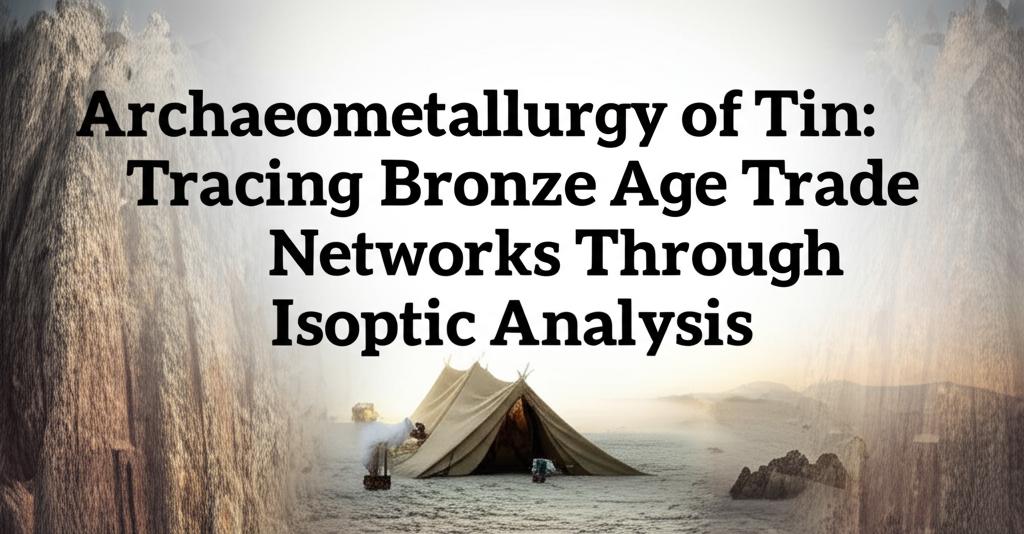The study of tin, a crucial component in the creation of bronze, is revealing intricate details about Bronze Age trade networks. Through advanced scientific techniques like isotopic analysis, researchers are now able to trace the origins of tin used in ancient artifacts, shedding new light on the vast distances this valuable commodity traveled and the complex relationships between ancient civilizations.
Bronze, an alloy of copper and typically around 10% tin, was a transformative material during the Bronze Age, used for everything from weapons and tools to jewelry and everyday objects. While copper sources were relatively common across Eurasia, tin deposits were much rarer and geographically scattered. This scarcity made tin a highly sought-after raw material, driving the establishment of extensive and complex trade routes.
Recent breakthroughs in geochemical analysis, particularly focusing on tin and lead isotopes combined with trace element analysis, have allowed archaeologists to pinpoint the geographic origins of tin with unprecedented accuracy. Previously, the precise sources of tin used in many Bronze Age cultures, especially those in the Eastern Mediterranean which had virtually no local tin deposits, remained a significant enigma.
Groundbreaking research published in 2025 has provided conclusive evidence that southwestern Britain, specifically Cornwall and Devon, was a major supplier of tin to Bronze Age Europe and even the Eastern Mediterranean. By analyzing tin ingots recovered from ancient shipwrecks off the coasts of Israel (dating to around 1300 BC) and southern France (around 600 BC), researchers were able to match their isotopic and elemental signatures to tin ores from these British regions. This indicates that tin mined by what were likely small farming communities in Britain was transported over 4,000 kilometers (2,500 miles) to major Bronze Age civilizations. This discovery highlights Britain's significant role in international trade networks much earlier than previously understood and suggests that tin was one of the first commodities to be exported across the entire continent in British history.
Further studies on artifacts and tin ingots, including those from the famous Uluburun shipwreck (c. 1320 BC) found off the coast of Turkey, have revealed an even more complex picture of tin procurement. Analysis of the Uluburun cargo, which contained roughly one ton of tin ingots alongside ten tons of copper, showed that the tin came from multiple sources. Approximately two-thirds of this tin originated from the Kestel mine in the Taurus Mountains of present-day Turkey. Surprisingly, the remaining one-third was traced to the Mušiston mine in Uzbekistan, over 2,000 miles away from where the ship loaded its cargo in the Levant. This finding underscores that Bronze Age trade networks were not only extensive but also involved multiple, culturally diverse groups, including small-scale mining communities and pastoralist groups in Central Asia, who were connected to vast international markets.
The development of new analytical protocols for tin isotope analysis has been crucial in these discoveries. Researchers have had to overcome challenges such as the insolubility of cassiterite (the primary tin ore) and the potential for isotopic fractionation (changes in isotope ratios) during smelting processes. By refining these methods, scientists can now more confidently link archaeological tin artifacts back to their original ore deposits. However, it is also recognized that the isotopic signatures of some tin deposits can overlap, making definitive provenancing a continued area of research. For example, while some studies point heavily towards Cornwall for Eastern Mediterranean tin, others suggest that multiple European sources, including those in the Erzgebirge (border of Germany and Czech Republic), were also exploited.
These archaeometallurgical investigations demonstrate that Bronze Age societies were interconnected by sophisticated and far-reaching trade routes. The demand for critical raw materials like tin, copper, amber, and glass fueled these early international trade networks. The ability to trace tin sources through isotopic analysis is not only solving long-standing archaeological puzzles but also providing deeper insights into the economic, social, and political dynamics of the Bronze Age world. Future research will continue to refine these techniques and expand our understanding of how different cultures interacted and exchanged goods, shaping the course of human history.

